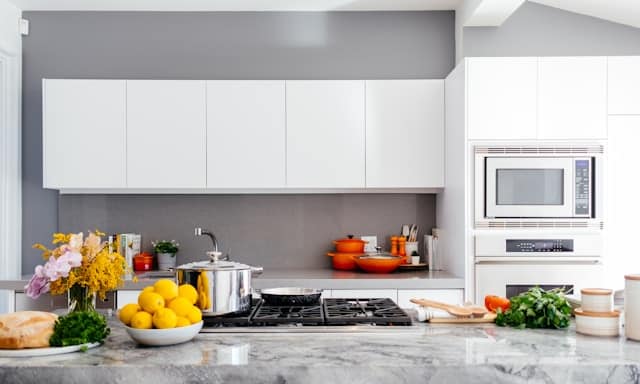How to Plan a Kitchen Layout That Encourages Family Collaboration in Cooking?

Planning a kitchen layout is not just about the aesthetics. It also involves careful consideration of the functionality of the space, the appliances to be used, and importantly, how to make the kitchen work for the entire family. In this article, we’ll explore how to design a kitchen that encourages family collaboration in cooking. We’ll delve into aspects like the efficient use of space, the choice of appliances, and the creation of an open design that facilitates interactions. Our guidance is backed by the wisdom of popular designers and the best practices shared on platforms like Houzz. So, let’s get started.
The Importance of an Efficient Layout
Before you delve into the type of cabinets or lighting fixtures you want, it’s essential to focus on creating an efficient layout. An efficient layout will allow for an easy flow of work, will make sure there is ample storage, and will keep the cooking space safe and comfortable. This forms the backbone of a kitchen that encourages collaborative cooking.
Sujet a lire : What Are the Benefits and Challenges of Installing Floor Heating in a Renovated Cottage?
One of the fundamental concepts in kitchen layout design is the work triangle. The work triangle is the imaginary line drawn between the sink, the refrigerator, and the hob or stove. The idea is to create a layout where these three most-used areas are in close proximity, making the cooking process smoother.
When planning the layout, consider the way you and your family cook. If multiple people are often involved in preparing meals, it might be helpful to have more space between these points, or even consider multiple work triangles.
Sujet a lire : What Are the Best Strategies for Creating a Visually Cohesive Flow in Open-Plan Homes?
Choosing the Right Appliances
Just as vital as the layout are the appliances you choose for your kitchen. You’d want to think about appliances that are user-friendly for everyone in the family, including children.
Consider appliances that are designed with safety features. For instance, induction cooktops stay cool to the touch and can be a safer option if you have young children participating in the cooking process.
Another essential factor in choosing appliances is to consider their placement. Wall ovens, for example, can be installed at a height that’s convenient for all family members. Finally, consider appliances that encourage collaboration, like a large stove or a double sink.
Designing for Storage
In a kitchen that sees multiple cooks, storage becomes even more critical. You’d want to ensure that everyone can easily access what they need.
Consider having open shelves for frequently used items, which can be reached by everyone. You might also want to have designated storage areas for each family member to keep their favorite cooking tools.
Creating an Open Space
An open kitchen design can do wonders to promote family collaboration. This layout removes barriers like walls or doors, making the room feel more spacious and inviting.
This design provides extra space to move around, making it easier for several people to work together. It’s also easier to communicate and interact with each other, making the cooking process more enjoyable.
Lighting Your Kitchen
Right lighting in your kitchen is critical not just for aesthetic reasons, but also for practicality. Good lighting can make your kitchen appear more spacious and can also help in carrying out tasks efficiently.
Consider having multiple light sources in your kitchen like ceiling lights, pendant lights over the island, and under-cabinet lighting. And remember, natural light is a boon. So, if it’s possible, include large windows in your kitchen design.
With the right blend of an efficient layout, user-friendly appliances, ample storage, open space, and proper lighting, you can create a kitchen that fosters family collaboration in cooking. And in doing so, you’re also encouraging a culture of togetherness, cooperation, and shared learning.
Remember, a kitchen is the heart of a home. And a heart is at its best when it’s beating in harmony with others. So start planning your kitchen layout today and create a space that brings your family together.
Incorporating a Kitchen Dining Area
Food is the ingredient that binds us together. This old saying has never been more true than when it comes in the context of a kitchen design that promotes family collaboration. An integral part of this design is incorporating a kitchen dining area.
By incorporating a dining area within your kitchen, you not only save on space but also promote a sense of togetherness. This open plan concept lets family members interact with each other while cooking, setting the table, or even doing homework. It’s a space that seamlessly integrates various activities, fostering stronger bonds amongst family members.
When planning your kitchen layout, keep in mind how the dining area will fit into it. If your kitchen is shaped like a rectangle, the dining table could be placed at the center or one end of the kitchen. For a U-shaped kitchen, consider placing the dining table in the open area within the ‘U’.
The dining area in the kitchen isn’t just about the table and chairs. It’s also about the storage. Consider adding kitchen cabinets or shelves near the dining area to store crockery and cutlery. This would help to keep the dining area clutter-free and functional.
Think about the traffic flow as well. The path from the stove, sink and refrigerator to the dining table should be clear. This would ensure that serving the food becomes a seamless task and doesn’t interfere with the cooking process.
Including Outdoor Elements
What about extending your kitchen to the outdoors? Linking indoor and outdoor spaces is a popular trend in kitchen design. An outdoor kitchen or an outdoor dining area can add a whole new dimension to your cooking and dining experience.
Including outdoor elements in your kitchen design can be as simple as having large windows that provide a view of your backyard or balcony. Or it could be more elaborate with features like an outdoor counter space for food preparation, an outdoor stove or grill, and even outdoor lighting for evening or night-time cooking.
Bathroom vanities can offer inspiration for outdoor kitchen cabinets, with their durability and stylish designs. Similarly, outdoor furniture can be chosen to withstand the elements while offering comfort and style.
Creating an outdoor extension of your kitchen is a fantastic way of adding more space for family collaboration. It’s like having a picnic in your own backyard, with the convenience of a well-designed kitchen at hand!
Conclusion: The Heart of The Home
Remember that the kitchen is more than just a room for cooking. It’s the heart of your home, where memories are created, traditions are honored, and the sense of family is strengthened. A well-designed kitchen that encourages family collaboration in cooking can do more than just produce nutritious meals – it can create joyful experiences, promote healthier relationships, and build life skills for everyone involved.
Whether it’s through an efficient work triangle, user-friendly appliances, ample storage, a comfortable dining area, an open concept kitchen, or outdoor elements, each aspect of your kitchen design plays a crucial role in fostering collaboration and togetherness.
As you embark on your journey to create your dream kitchen, remember that the ultimate goal is to create a welcoming, functional, and inviting space that brings your family together. So, go ahead and dream big, plan well, and cook with love. After all, the best family memories are made when gathered around the kitchen.
